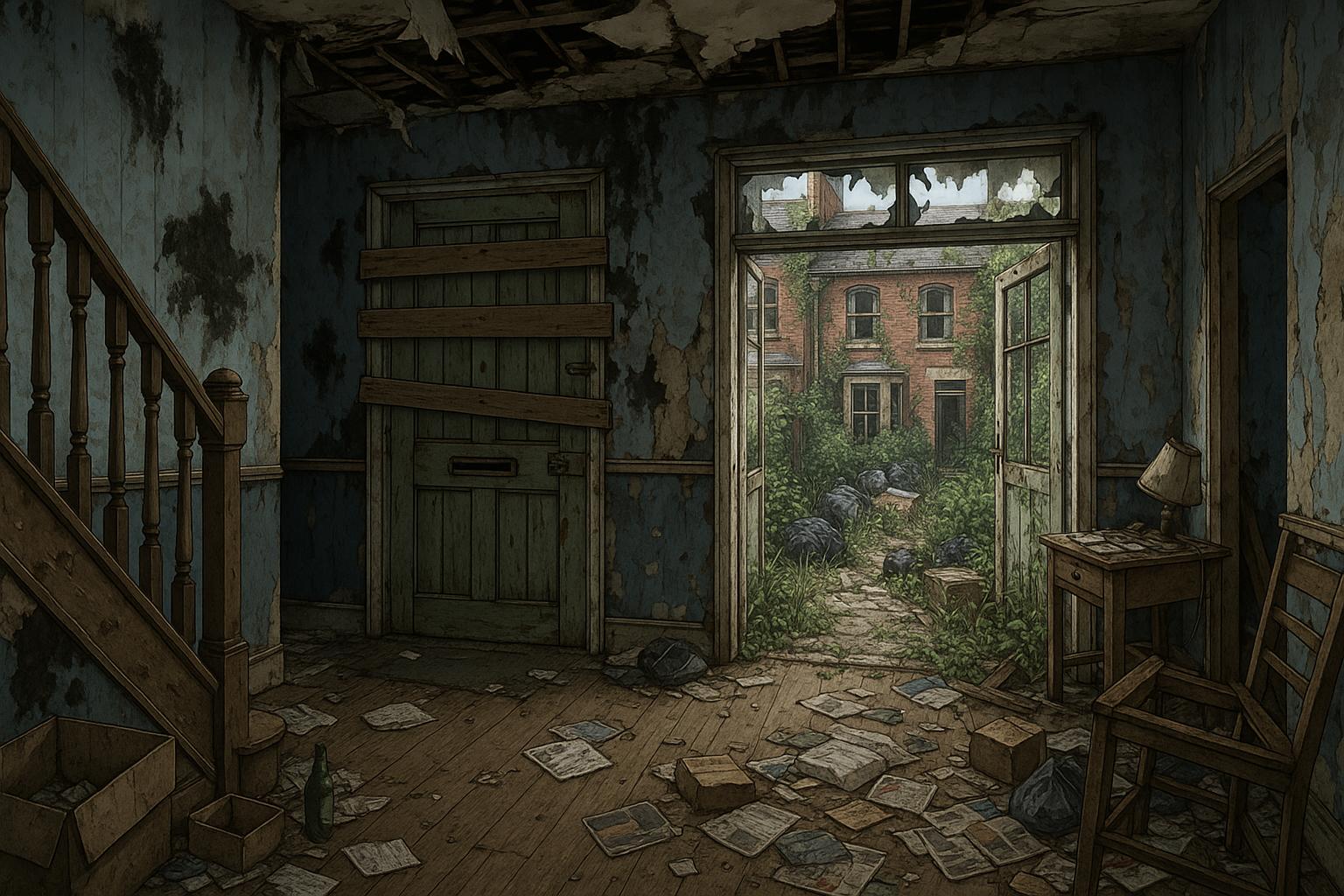A London property priced under £1 million reveals extensive damp and mould damage amid growing concerns about housing conditions across the city, highlighting the pressing need for improved standards to protect residents’ health.
A three-bedroom property in London has recently been listed for under £1 million, but its unique price tag stems from the property’s dire condition. Described by the estate agent Winkworth as a “fantastic opportunity” for prospective buyers, the home features a boarded-up entrance that hints at the extensive renovations required inside.
Inside, the property’s current state is alarming. The kitchen bears the scars of neglect, showcasing ripped-up floorboards and a crumbling ceiling, while precariously hanging cupboards show signs of deterioration. The living room’s wallpaper is marred by patches of black mould, and clutter stirs an odd assortment of items, from a black wheelie bin to an Eiffel Tower-shaped lampshade. Such neglect raises significant concerns about living conditions, particularly as recent research indicates that a staggering 60% of residents in England have reported mould within their homes, according to data compiled by Uswitch.
This bleak interior narrative is compounded by findings from the newly published report highlighting that eight of the top ten local authorities with the highest complaints about damp and mould are located in London, with Haringey ranking first. The poor state of housing not only diminishes the value of properties but poses severe health risks for residents, particularly children, the elderly, and individuals with pre-existing conditions.
Prospective buyers are met with a dirty, uncarpeted staircase leading to bedrooms that offer little refuge from the property’s overall disrepair. One of the bedrooms is notable for its picturesque fireplace but is otherwise plagued by crumbling, mould-ridden wallpaper and a decaying ceiling. Compounding the issue, an overgrown garden has become a makeshift rubbish dump, with a collection of discarded household items, including a bicycle amidst weeds and litter, reinforcing the property’s state of abandonment.
In light of deteriorating housing conditions, the rise in complaints concerning damp and mould has sparked a nationwide conversation about public health and housing quality. Reports suggest that the prevalence of mould and damp extends beyond aesthetics; it directly correlates to health issues, including respiratory problems, which the NHS reportedly spends around £1.4 billion annually to treat. Vulnerable groups are at an even greater risk, indicating that addressing these issues is crucial for improving tenant well-being and overall public health.
The listing for this home also mentions possibilities for extending into the loft, subject to planning permission, which could appeal to buyers eager to invest in a potential long-term asset. However, the overwhelming message remains that this “fantastic opportunity” is shrouded in substantial challenges that await any new homeowner. Given the extensive renovations needed, an internal viewing is highly recommended to fully grasp the scale of work required.
Ultimately, this property serves as a stark reminder of the urgent need to improve housing standards in London and beyond. With a significant portion of the population grappling with similar issues, it is increasingly vital that local authorities and housing providers prioritise action against damp and mould, ensuring safe and healthy living environments for all.
Reference Map
- Paragraph 1: [1]
- Paragraph 2: [1], [2]
- Paragraph 3: [1], [2], [3]
- Paragraph 4: [1], [2], [4]
- Paragraph 5: [1], [5], [6]
- Paragraph 6: [1], [7]
Source: Noah Wire Services
- https://www.dailymail.co.uk/news/article-14716729/Three-bedroom-London-terrace-sale-inside.html?ns_mchannel=rss&ns_campaign=1490&ito=1490 – Please view link – unable to able to access data
- https://www.standard.co.uk/news/london/london-borough-damp-mould-rankings-england-b1216006.html – A report by Uswitch reveals that over 60% of UK residents have experienced mould in their homes, with eight of the top ten local authorities receiving the most complaints about damp and mould located in London. Haringey topped the list, followed by Hammersmith and Fulham, Lambeth, Lewisham, and Camden. The prevalence of mould in these areas highlights significant housing quality issues affecting residents’ health and well-being.
- https://www.theguardian.com/uk-news/2023/nov/12/how-harmful-is-damp-and-mould-in-uk-homes-and-who-is-most-at-risk – Approximately 3% of flats and homes in the UK are classified as having damp, but the actual number is likely higher. Damp and mould can lead to various health issues, including respiratory problems and mental health effects. Vulnerable groups such as children, the elderly, and those with existing health conditions are particularly at risk. Addressing damp and mould is crucial to improve public health and housing quality.
- https://www.theguardian.com/society/2023/feb/02/mould-damp-complaints-social-housing-ombudsman-tenants-landlords – Formal complaints to the housing ombudsman about damp, mould, and leaks in social housing are expected to reach 5,300 for the year to March, up from fewer than 2,000 in 2020-21. The death of Awaab Ishak, a two-year-old child from Rochdale, due to prolonged exposure to mould, has intensified scrutiny of housing conditions and prompted calls for stricter regulations and faster responses from landlords.
- https://www.greenenergyswitch.co.uk/2025/01/29/damp-and-mould-the-impact-on-residents-and-landlords/ – Exposure to damp and mould in housing can lead to serious health issues, including respiratory problems and mental health effects. Approximately 40% of renters report high stress related to damp, mould, and cold conditions in their homes. The NHS reportedly spends approximately £1.4 billion annually on treating illnesses linked to damp and mould in housing. Addressing these issues is essential for improving public health and tenant well-being.
- https://www.hvnplus.co.uk/news/new-study-cites-rise-in-damp-and-mould-complaints-in-uk-housing-21-01-2025/ – A recent study indicates a significant rise in damp and mould complaints in UK housing. Haringey received an estimated 31 complaints per 10,000 housing units, making it the most complained about local authority to the Housing Ombudsman. Other high-ranking areas included Hammersmith and Fulham, Lambeth, Lewisham, and Camden. The study highlights the urgent need for improved housing conditions and faster responses to tenant complaints.
- https://www.cih.org/blogs/stagnating-progress-on-damp-mouldy-homes-the-uk-housing-review-2023/ – The UK Housing Review 2023 reveals that the prevalence of damp in English housing has remained around 4% for over a decade, affecting approximately 904,000 homes. The private rented sector is the most affected, with 10.7% of properties showing some incidence of damp. Despite efforts, progress in eradicating damp from the UK’s housing stock has stalled, underscoring the need for renewed focus and action.
Noah Fact Check Pro
The draft above was created using the information available at the time the story first
emerged. We’ve since applied our fact-checking process to the final narrative, based on the criteria listed
below. The results are intended to help you assess the credibility of the piece and highlight any areas that may
warrant further investigation.
Freshness check
Score:
8
Notes:
The article is recent and discusses current housing issues in London, such as damp and mould complaints. However, it does not include specific dates or indicators of new developments.
Quotes check
Score:
0
Notes:
No direct quotes are found in the narrative provided.
Source reliability
Score:
6
Notes:
The narrative originates from the Daily Mail, a known publication, but its reliability can vary depending on the topic and context. The Daily Mail is not typically considered as highly reliable as other major news outlets like BBC or Financial Times.
Plausability check
Score:
8
Notes:
The claims about damp and mould in UK homes are plausible and align with recent reports and studies. The specific details about the property’s condition and the challenges faced by buyers are consistent with common issues in neglected properties.
Overall assessment
Verdict (FAIL, OPEN, PASS): OPEN
Confidence (LOW, MEDIUM, HIGH): MEDIUM
Summary:
The narrative is plausible and discusses current issues related to housing conditions in London. However, the reliability of the source is moderate, and there are no direct quotes to verify. The information appears to be recent but lacks specific dates for some claims.













